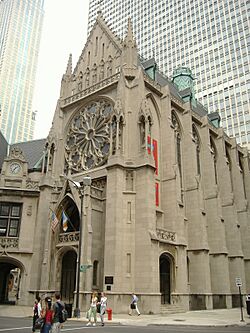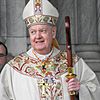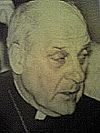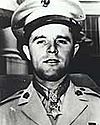Archbishop Quigley Preparatory Seminary facts for kids
Quick facts for kids Archbishop Quigley Preparatory Seminary |
|
|---|---|
 |
|
| Address | |
|
103 East Chestnut Street
, |
|
| Coordinates | 41°53′52″N 87°37′33″W / 41.89778°N 87.62583°W |
| Information | |
| Type | private high school seminary |
| Motto | Ora et Labora (Pray and work) |
| Denomination | Roman Catholic |
| Established | 1918 (as Quigley Seminary) |
| Founder | George Mundelein |
| Status | closed (Archdiocese now uses historic structure for other purposes) |
| Closed | 2007 |
| Oversight | Archdiocese of Chicago |
| Grades | 9–12 |
| Gender | all-male |
| Campus type | Urban |
| Color(s) | Navy blue and White |
| Team name | Phoenix |
| Newspaper | The Talon |
|
Quigley Preparatory Seminary
|
|
| Lua error in Module:Location_map at line 420: attempt to index field 'wikibase' (a nil value). | |
| Built | 1917 |
| Architect | Zachary Taylor Davis |
| Architectural style | Late 19th And 20th Century Revivals |
| NRHP reference No. | 96000093 |
| Added to NRHP | 16 February 1996 |
Archbishop Quigley Preparatory Seminary was a special high school in Chicago, Illinois. It was for young men who were thinking about becoming Catholic priests. The school was run by the Roman Catholic Archdiocese of Chicago.
It was located in downtown Chicago at 103 East Chestnut Street. The school closed on June 22, 2007. After some updates, the building became the Archbishop Quigley Center. This is now the main office for the archdiocese. For a while, from 1961 to 1990, the seminary had two campuses: Quigley South and Quigley North. Quigley North was in the original building. After Quigley South closed in 1990, all school activities moved back to the original building.
The school started as Cathedral College of the Sacred Heart in 1905. In 1916, Cardinal George Mundelein planned a new building for the seminary. He named it after his leader, Archbishop James Edward Quigley. Cardinal Mundelein wanted the school to be very beautiful. He said it would be "the most beautiful building here in Chicago."
Quigley's Chapel of St. James has amazing stained glass windows. They were inspired by the Sainte-Chapelle in Paris. The chapel was finished on June 10, 1920. It was designed by architect Zachary Taylor Davis. The chapel has been on the National Register of Historic Places since 1996.
Many important people studied at Quigley. Almost 2,500 priests graduated from the Quigley seminaries. This includes two cardinals and over 40 bishops. Some alumni also received high honors like the Medal of Honor. Two former students are even in the Basketball Hall of Fame.
Contents
How Did Quigley Seminary Begin?
Archbishop James E. Quigley started planning a smaller seminary in Chicago in 1903. At that time, Chicago needed more priests. There were only about 417 priests for nearly 1.7 million people. Archbishop Quigley chose Rev. Francis Andrew Purcell to lead the new school. He sent him to Rome to study.
The first school, Cathedral College of the Sacred Heart, opened on October 2, 1905. It was located in the city center, like many European seminaries. Students went to school on Saturdays and had Thursdays off. The first 52 students did not pay tuition. This started a tradition that money should not stop a student from attending.
Archbishop Quigley bought land for a larger seminary. But his health failed before he could finish his plans. Before he died in 1915, he shared his ideas with George Mundelein. Mundelein was then a bishop from Brooklyn. When Mundelein became Archbishop of Chicago in 1916, he put Quigley's vision into action.
In 1916, Mundelein bought land for the new seminary on Rush Street. He sold other land to help pay for it. Construction began in November 1916. The first classes were held at the new location in September 1918.
The new "Quigley Memorial Preparatory Seminary" started with a five-year program. It was a day school, meaning students went home each day. This was so students could stay connected with their families and church.
By 1922, Quigley Seminary was already too crowded. It had over 600 students, but was built for 500. A new part of the building was added in 1925. This increased the school's capacity by another 500 students.
Msgr. Purcell, the first rector, started the school newspaper, The Candle. He also started the yearbook, Le Petit Seminaire. He created the Cathedral Choristers, a boys' choir that sang at Sunday Masses. By 1931, Quigley had grown to 1,030 students and 42 teachers. Quigley's priest teachers lived in local parishes. This helped them stay connected to parish life.
Msgr. Philip Francis Mahoney became rector in 1931. He was followed by Msgr. Malachy P. Foley in 1935. Msgr. Foley encouraged teachers to get advanced degrees. He also met with students often to help them. He wanted Quigley to be one of the best high schools.
Changes from the 1940s to 1970s
Msgr. John W. Schmid became the fourth rector in 1944. He added more language classes and made sciences and physical education required. By 1955, Quigley had 1,300 students. Msgr. Schmid started planning for the school to grow even more.
Msgr. Martin M. Howard became rector in 1955. He worked with Cardinal Samuel Stritch to change Quigley to a four-year program. They also planned to build a second Quigley school. The Archdiocese rented another building, the Ogden School, to help with the large number of students.
Cardinal Stritch died in 1958. His successor, Cardinal Albert Gregory Meyer, continued the plans. A new high school, Quigley Preparatory Seminary South, opened in 1961. It was located at 77th Street and Western Avenue. Msgr. Howard became its first rector. The original school was then called Quigley Preparatory Seminary North.
Cardinal Meyer dedicated Quigley South on September 13, 1962. It had a 40-acre (16 ha) campus and 869 students. For a short time, both Quigley campuses held events together. This helped students feel like they were part of one big school.
Msgr. John P. O'Donnell became rector of Quigley North in 1961. He encouraged teachers to get degrees from many universities. Cardinal Meyer believed that young seminarians needed many priest role models. In 1965, Quigley North became accredited. It also started offering Advanced Placement classes. Around this time, Quigley North began to see fewer students joining.
In 1966, Cardinal John Patrick Cody changed the seminary system. Students no longer had Thursdays off and Saturdays on. Teachers also changed their dress code. Rules about students participating in co-educational activities were updated. In 1968, student dress codes were changed to fit the seasons. Quigley students could also join the National Honor Society.
In 1970, Cardinal Cody announced new rules for who could join Quigley. Before, students had to be sure they wanted to become priests. Now, boys who showed good character and ability could also be admitted. This new policy aimed to help more students discover if they had a calling to the priesthood.
Pope John Paul II's Visit in 1979
On October 5, 1979, Pope John Paul II visited Quigley South. He gave a special speech to the students from both Quigley schools. He told them:
"Dear seminarians, I want you to know that you have a special place in my thoughts and prayers. Be strong in your faith. Study the faith carefully. And nourish your faith each day at Mass. God bless you."
He also added, "See how important you are—The Pope comes to visit you!"
Living at Vianney Hall (1981–1987)
In 1981, Quigley North tried something new. They opened an off-campus residence hall called St. John Vianney Hall. It was for students who lived far away from Chicago. These students could live there Monday through Friday during the school year.
Priests and laymen lived at Vianney Hall to supervise the students. Students came from many different suburbs. The daily schedule included waking up early, chapel service, and breakfast. Students took public transportation to Quigley North. After school, they had dinner, study hours, and evening chapel service.
The hall had a basketball court for recreation. Younger students shared rooms, while older students had single rooms. This living arrangement helped students become more independent. However, the program ended in 1987 due to financial reasons and low enrollment in the college seminary. This was the only time Quigley offered a dormitory option.
Quigley's Later Years (1980s to 2007)
By 1989, fewer Quigley graduates were becoming priests. The Archdiocese decided to close both Quigley North and Quigley South in June 1990. They combined both schools into Archbishop Quigley Seminary at the original downtown location.
Students and alumni protested the decision. But many later supported the new combined school. The Quigley South campus was sold to St. Rita High School. The reorganized Archbishop Quigley Preparatory Seminary received national recognition in 1999. US News and World Report named it one of 96 outstanding high schools in America.
From 1984 to 1993, about 5 to 6 students each year from Quigley became priests. In Fall 2006, Quigley had 183 students. It was the largest of the seven remaining preparatory seminaries in the country.
For most of the 20th century, Quigley students had to attend Mass every day. This changed in the early 1990s to a weekly Mass. However, when Rev. Peter Snieg became rector in 2001, prayer became a main focus again. Students were required to attend Mass three days a week. They also had morning prayer on Mondays and afternoon prayer on Fridays.
On September 19, 2006, the Archdiocese announced that Quigley would close. The school shut its doors to students at the end of the school year in June 2007. After renovations, the building became the archdiocesan Pastoral Center. A "Quigley Scholars" program was started to help high school boys interested in becoming priests.
School Life and Traditions
- Beadsmen—A group of Quigley students who prayed the Rosary together in the chapel. They also did service projects.
- Big Brother Little Brother Program—Older students (seniors) would help new students (freshmen) get used to the school.
- Candle—The student newspaper for Quigley, and later Quigley North.
- Cathedral Choristers—A boys' choir from Holy Name Cathedral. Quigley students with good singing voices were required to join. They sang at the Cathedral and at Quigley.
- Chapel—Often referred to the daily or weekly Mass and prayers at Archbishop Quigley.
- Christmas Wreath Toss—During a faculty party, teachers would try to toss a wreath onto the arm of a statue of Cardinal John Newman.
- The Crow's Nest—The highest office in the Quigley building. Students and teachers would sometimes sign their names in the east attic, called Memorial Hall, which was accessed through this office.
- Daily Mass—For many years, Quigley students had to attend Mass every morning at their home parish.
- Day off—Sometimes, if a bishop visited Quigley for Mass, students might get the rest of the day off school.
- Demerit—A penalty for breaking school rules. Too many demerits could lead to suspension or expulsion.
- Lenten Lob—A fun tournament held during Lent to raise money for Catholic Missions. Students and teachers would "lob" balls into a bucket from different parts of the gym.
- Lenten Tournament—An indoor basketball tournament held during Lent.
- Mission Party—An after-school event with games, movies, and snacks. The money raised went to Catholic Missions.
- Mission Walk—Students would walk long distances, sometimes up to 55 miles (89 km), to raise money for Catholic Missions. Later, the walk was shorter, often around Wrigley Field.
- No girls—Until 1966, Quigley students were not allowed to date or join clubs with girls without special permission.
- Pastor's signature—In earlier years, a student needed a letter of recommendation from their pastor to enter Quigley. Pastors also had to sign student report cards.
- Schola, or Schola Cantorum—A small group of Quigley students trained to sing Gregorian Chant.
- The Talon—The official student newspaper of Archbishop Quigley from 1990 until it closed.
- Thursday off, Saturday on—Until 1966, Quigley students had school on Saturdays and a day off on Thursdays. On Thursdays, students often went to local parish gyms.
Notable Alumni
Bishops
- Alfred Leo Abramowicz (Q '37) – A bishop who helped the Solidarity movement in Poland.
- Edward Egan (Q '51) – A Cardinal who was the Archbishop of New York City.
- Wilton D. Gregory (QS '65) – The first African American archbishop to become a Cardinal. He is the Archbishop of Washington, D.C.
- Paul Casimir Marcinkus (Q '40) – An archbishop who worked in the Vatican, leading the "Vatican Bank."
- Thomas J. Paprocki (QS '70) – The Bishop of Springfield, Illinois.
Other Clergy
- Daniel Coughlin (Q '53) – The first Roman Catholic to be the Chaplain of the United States House of Representatives.
- Monsignor John Joseph "Jack" Egan (Q '37) – An author and activist for social and civil rights.
- Rev. Andrew M. Greeley (Q '47) – A well-known author, journalist, and sociologist.
- Monsignor George G. Higgins (Q '34) – An author and civil rights activist who received the Presidential Medal of Freedom.
- Michael Pfleger (QS '67) – A pastor and civil rights activist.
Other Notable People
- Michael Edward Harper (QS '76) – A former professional basketball player in the NBA.
- John H. Leims – A U.S. Marine who received the Medal of Honor for his bravery during World War II.
- Harry Lennix (QS '83) – A television and film actor.
- George Mikan (Q' 41) – A Hall of Fame basketball player. He was named one of the greatest players of basketball's first 50 years.
- Antonio Munoz (QS '82) – An Illinois State Senator.
- Richard Phelan (Q '55) – An attorney and former President of the Cook County Board.
- Dan Savage (QN '82) – A political writer and co-founder of the It Gets Better Project.
|






